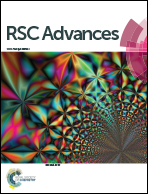High-performance carbon-based solid acid prepared by environmental and efficient recycling of PVC waste for cellulose hydrolysis†
Abstract
Pyrolysis techniques can provide a way to convert polyvinyl chloride (PVC) waste into high value liquids and gases. The inexpensive pyrolysis residue was used to successfully prepare a carbon-based solid acid (CSA) bearing –Cl functional group by a simple process, which has been shown to be highly effective for hydrolyzing microcrystalline cellulose into reducing sugars. The structure, acidic functional group density and catalytic activity of PVC-derived CSA (PCSA) were investigated. The results showed that the carbonization time has an important influence on the structure and properties of the PCSA, especially in a lower temperature range. There was a compensation effect between the carbonization temperature and time on the structure and the activity of PCSA. Phenolic-OH and –Cl groups acted as double cellulose-binding sites and together improved the adsorbability of PCSA, which is much higher than that of traditional CSA and other CSAs bearing –Cl groups. The high hydrolytic activity was determined by the adequate density of the –SO3H group, the excellent adsorption property, and the entire structure of the PCSA.


 Please wait while we load your content...
Please wait while we load your content...